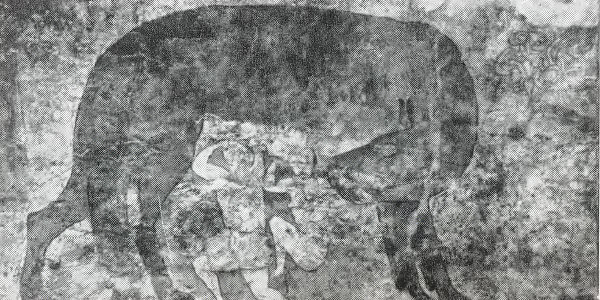
As the southernmost part of the Russian Empire and the former Soviet Union, the geographic area now known as Jumḣurii Tojikiston or Tojikiston, was influenced by the literary traditions of the Persian, Turkic, Chinese, Tibetan, Indian, and Islamic empires of the region. These traditions were largely based on manuscripts and illuminated manuscripts. The establishment of a modern printing culture with an administrative infrastructure, which supported the vernacular language, did not appear until the 1920s. The start year for publications in Tajik or Tojikī [Tadzhiki] is 1923, when the Commissariat of Education of the Bukharan People’s Soviet Republic [Bukharskaia Narodnaia Sovetskaia Respublika] published a collection of Tojikī revolutionary poetry by the founder of Soviet Tojik literature, Sadriddin Aǐnī (1878 – 1954). In October 1925 in Dushanbe, the Tojik State Publishing House was established, which by 1928, produced 56 monographic titles in the Tojikī language with approximately 281,000 copies.
With a decree from the Central Executive Committee and the Council of People’s Commissars of Tojikiston, the founding of the book chamber, which occurred officially on August 11, 1937[even though it was organized in December 1936], inaugurated the birth of national bibliographic publications in Tojikiston. During the 1937 – 1958 period, the Book Chamber of Tojikiston started and continued the following national bibliographic publications in varying frequency: Knizhnaia letopis’ [for 1937-1938 period] (published in 1939, includes Tojikī and Russian titles); Letopis’ gazetnykh stateǐ [for 1939] (published in 1940); Letopisi maqolaḣoi gazetavī = Letopis’ gazetnykh stateǐ (1939-1949); Letopisi matbuoti Tojikiston = Letopis’ pechati Tadzhikistana [1941: No. 1 (January), 35 pages; No. 2 (February), 28 pages; monographs, articles from journals, national and regional newspapers; languages covered: Tojikī, Russian, and Uzbek titles]; Solnomai kitob va zhurnalḣo = Knizhno-zhurnal’naia letopis’[for 1947, published in 1948. Monographs and articles from journals, 55 pages]; Solnomai kitobḣoi soli 1949 = Knizhnaia letopis’ 1949 g [Russian and Tojikī monographs, 48 pages]; Letopisi kitobii solḣoi = Knizhnaia letopis’ (1938-1948) [Published in 1949; Total number of titles: 618. Tojikī and Russian titles]; Solnomai matbuoti RSS Tojikiston = Letopis’ pechati Tadzhikskoǐ SSR [1939-]; Letopisi Matbuoti davragii RSS Tojikiston = Letopis’ periodicheskikh izdaniǐ Tadzhikskoǐ SSR (1952)[published in 1953, 24 pages].
Although these publications give researchers and information professionals an idea of what was being published in Tojikiston, the clarity sought by researchers can be achieved by consulting Matbuoti RSS Tojikiston 1928-1958: materialhoi statistiki (Pechat’ Tadzhikskoi SSR 1928-1958: statisticheskie materialy), which outlines in detail the number of materials produced in Tajikistan for the stated period. For example, Tables 1-4 chronologically lists the number of monographs, journals, and newspapers published by various institutions in Tajikistan.
![monographs published in Tojikiston [1928-1958]](/slavic/wp-content/uploads/sites/100/2017/06/monographs_publishing_table_1928_1958.jpg)
![monographs [author name] published in Tojikiston [1928-1958]](/slavic/wp-content/uploads/sites/100/2017/06/monographs_writers_publishing_table_1928_1958.jpg)
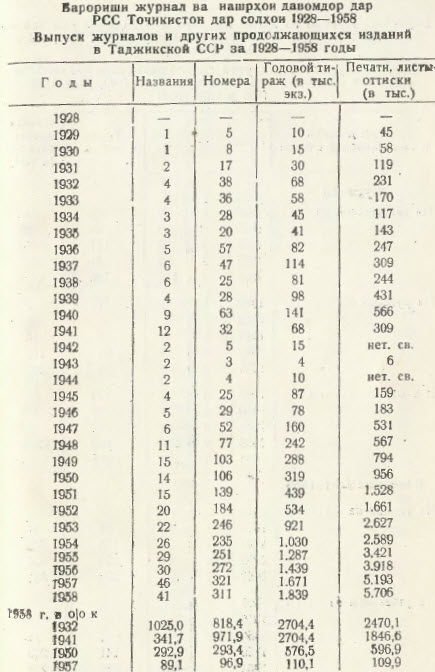
![Newspapers published in Tojikiston[1928-1958]](/slavic/wp-content/uploads/sites/100/2017/06/newspapers_publishing_table_1928_1958.jpg)
Moreover, the statistical handbook includes individual titles list, author name directory and the corresponding number of titles associated with the author, and an annotated list of journals and newspapers accompanied by publication statistics.
As with any ethnic group within the Soviet administrative control, identity as it appeared in print within the territory of Tojikiston, was carefully crafted and promoted to the masses. Therefore, when researching the publishing history of Tojikistaon, one must view the information produced as a partial view of publishing in Tojikiston. To compensate for coverage deficiencies, for example, when researching political Islam in Tojikiston and ethnic nationalism during the Soviet period, researchers can rely on alternatives to the publications originating from Tojikiston. The collections at the National Library of Iran should be consulted in addition to the national library in Dushanbe. Due to the events surrounding the Soviet-Afghan War (1979-1989) and the Tojik Civil War (1992-1997) libraries [academic and specialized libraries] in Tojikiston are still in the process of rebuilding their collections and online presence.
As of August 2012, a functioning online catalog [in Tojikī or in Russian] is yet to be available. The national library in Dushanbe, Kitobkhonai Millii Jumḣurii Tojikiston ba nomi Abulqosim Firdavsī = Natsional’naia biblioteka Tadzhikistana im. Abulkasima Firdavsi, does maintain a publications page. Researchers can view and download the materials published or digitized by the national library at: http://nlrt.tj/nashrhoi-mo.html [Note: the list of e-books on CDs published by the national library can be viewed at: http://nlrt.tj/nashrhoi-mo/33-2011-07-18-03-30-33.html]. In addition to the publications page, researchers can also view and download the official journal of the national library: Китобдор. This guide to Tojik National Bibliography is not intended to be comprehensive in scope. However, it does provide an overview of the most important national bibliographic publications. This guide consists of three sections: a national bibliography section, monographic resources, and periodical resources. For supplemental sources for Tojikiston, researchers are encouraged to consult the following sources:
1. Periodicheskaia pechat’ sssr (1917-1949): bibliograficheskiǐ ukazatel’: zhurnaly, trudy i biulleteni svodnye ukazateli [U of I Library Call Number: 016.057 V96 p]. List of Tojikī publications.
2. Gazety sssr (1917-1960): bibliograficheskii spravochnik. Tom 1: Gazety Moskvy, Leningrada i stolits soiuznykh respublik [U of I Library Call Number: 016.077 G2582 v. 1]. List of Tojikī publications.
3. Letopis’ periodicheskikh izdanii sssr [U of I Library Call Number: 016.077 L56]. List of Tojikī publications: NEWSPAPERS (1955-1960), NEWSPAPERS (1961-1965), and JOURNALS.
4. Letopis’ zhurnal’nykh statei. [U of I Library Call Number: 057 LE].
LIBRARY CATALOGS
Katalog literatury na tadzhikskom yazyke [microform]. Rossiǐskaia natsional’naia biblioteka. Otdel literatury na natsional’nykh iazykakh.
New York : N. Ross, 1997. U of I Library Call Number: MFICHE 016.9586 R736K International and Area Studies Library, Microfilm Room. U of I Library record. OCLC Accession Number: 47204938.
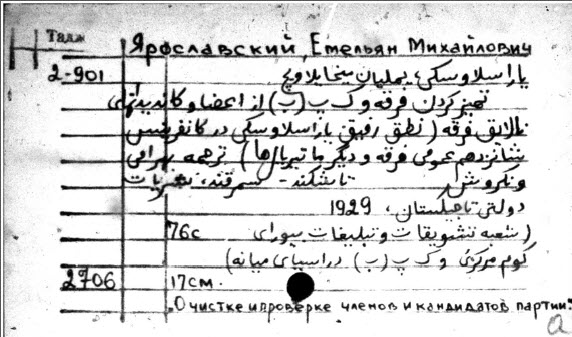
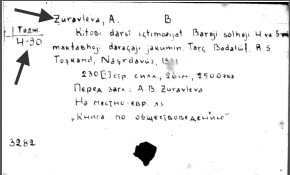
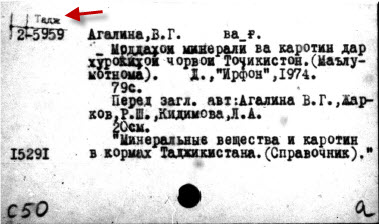
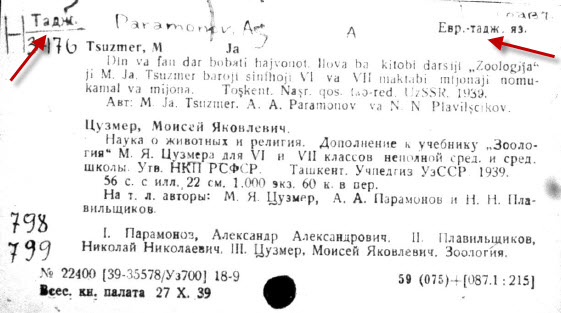
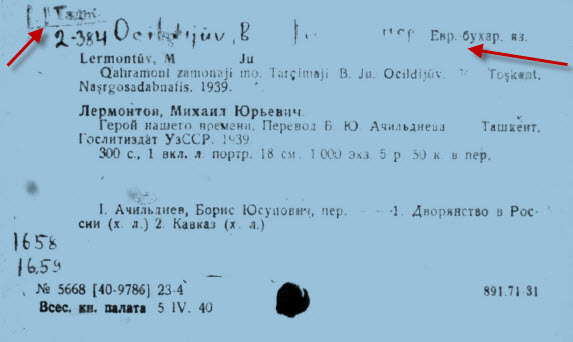
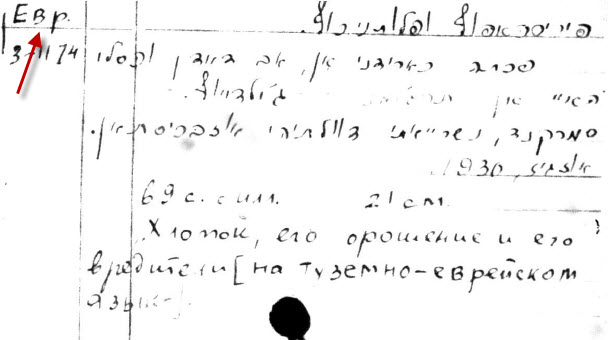
The Russian National Library’s Department of Literature in National Languages [also known as the Department of National Literatures] of the Russian Federation, Commonwealth of Independent States, and the Baltic countries has reproduced holdings catalogs in microfiche format. Although researchers can search Georgian, Armenian, and Finno-Ugric imprints through an online union catalog and databases at the Russian National Library [See: Сводный электронный каталог на финно-угорских языках = Svodnyǐ ėlektronnyǐ katalog na finno-ugorskikh iazykakh; Алфавитный каталог книг на армянском языке (1623- ) = Alfavitnyǐ katalog knig na armianskom iazyke (1623-); Алфавитный каталог книг на грузинском языке (1629-) = Alfavitnyǐ katalog knig na gruzinskom iazyke (1629-)], the national languages imprints catalogs in microfiche format diffuse most of the difficulties associated with transliteration in the vernacular languages, spelling, forms of entry, and uncertainties with the entirety of the collection. Researchers can access the entire holdings for a specific language at the Russian National Library through the microfiche set, conveniently exporting selected titles via PDF scans. As of August 21, 2012, U of I Library has purchased ~74 imprints catalogs [See: U of I Library holdings] on microfiche from the Russian National Library for the national languages of the former Soviet Union and the indigenous languages of the Russian Federation. The catalog of Tojik imprints at the Russian National Library consists of ~26, 550 titles and is divided into four sections:
1. Imprints in Latin script with corresponding Russian titles for most of the titles listed in this section [Please click on the image above];
2. Imprints in Arabo-Persian script with corresponding Russian titles for most of the titles listed in this section [Note: Arabo-Persian alphabet aid is included before the start of this section. The titles are organized according the Arabo-Persian script. Please click on the image above];
3. Imprints in Cyrillic, which is the largest section [Please click on the image above];
4. Imprints in Judeo-Persian [Bukhari/Bukhori] and Hebrew [Please click on the images above]. Note: this catalog has two different entries for Judeo-Persian: Bukharsko-evreǐskiǐ iazyk and Tadzhiksko-evreǐskiǐ iazyk.
With an approximate number of titles being close to 26, 550, the Tojik imprints catalog offers scholars in North America and Europe a comprehensive look at the holdings of the Russian National Library.
Feḣristi dastkhatḣoi sharqii akademiiai fanḣoi RSS Tojikiston [Jildi 1-6] = Katalog vostochnykh rukopiseǐ akademii nauk Tadzhikskoǐ SSR: rukopisi na Tadzhiksko-Persidskom, Uzbekskom i Azerbaǐdzhanskom iazykakh [Tom 1-6].
Dushanbe: Nashriëti “Donish,” 1960-. U of I Library Call Number: 016.091 AK132K Oak Street Facility [request only]. OCLC Accession: 17922282. UIUC Record.
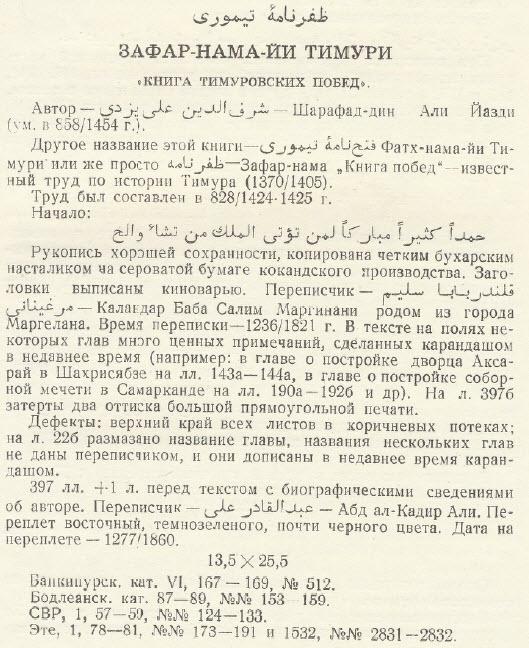
In 1951 the Academy of Sciences of Tojikiston was founded, and in 1953 a decision was made to centralize the holdings of all the libraries that have had some manuscript holdings in one central fond of the academy’s library. The catalog of oriental manuscripts of the Academy of Sciences of Tojikiston, as described in volume one, contained 3054 volumes of manuscripts in Tojikī, Persian, Arabic, Uzbek, and other oriental languages. The manuscripts range in time from the 13th to the 20th century.
By 1955 all the works in the fond were cataloged using a library card system, with each card bearing 19 bibliographic rubrics, such as author, title, place of writing or copying, and type of script. The project of describing the fond continued and by 1959 the annotations of manuscripts in Tojikī, Persian, and Turkic languages was finalized. The result was the publication of volume one in 1960, which includes manuscripts on history, geography, historical topography, memoirs, historical biographies, and other documents. This volume contains a total of 288 annotations.
The principles guiding the annotations for this catalog [volumes 1-6] are as follows:
- In the upper left corner there is the ordinal number indicating the order of the manuscripts described, while in the upper right there is the number the manuscript has within the fond. If an item contained more than one work, bound together, the number of item was given in Arabic numerals, and the number of a particular work in roman numerals, for example: 113/IV;
- The title of work is given in the Arabic script, as well as in Cyrillic. The translation of the title is provided. When exact title was unknown, an approximate title was provided and set off by square brackets;
- Author name is given both in Arabic and Cyrillic scripts. Additionally, the dates of the author’s life are given in Islamic and Gregorian calendar. Wherever possible, brief biographical annotations about the author are provided, with the sources of information indicated. Moreover, if there are works that provide erroneous information about the author, these are also pointed out. In several cases, it was impossible to verify the authorship and the works are marked as anonymous;
- Language of the work is indicated using an abbreviation: u. =Uzbek, tur. = Turkish, etc.;
- The work is briefly described, with longer descriptions reserved for lesser known, rare, or previously undescribed works;
- The date of the works is given according to both Islamic and Gregorian calendars;
- If a work is a translation, the name of the translator and date or translation are given. If the translation introduced changes to the original text, these are pointed out;
- If a manuscript is a collection of several works by a single author, each work is analyzed separately;
- The physical details of the manuscript are noted, such as number of columns, paper type, adornments, etc.;
- Miniatures and drawings are listed and briefly described;
- Any notes on margins are noted, as are all the possible defects of the manuscripts;
- If the manuscripts are correspondence, names of correspondents and brief information about them is included;
- All stamps and seals are described and dated (if possible);
- The number of pages, their size, as well as physical details of binding are indicated;
- Further, the following bibliographic information is provided (where applicable): catalogs where the work is listed, other copies of the work in existence (including translations).
- The second volume contains 490 descriptions [No. 289-757] of the manuscripts written in Tojikī and Turkic languages. The descriptions of items in this volume have been prepared according to the principles laid out in the introduction to volume one. However, since the manuscripts differ in their character from the works described in volume one, there is a number of differences in the way they are presented.
This volume and the next three volumes are devoted to belles lettres. It was decided that the descriptions of poetic and artistic prose found in the collections of the Academy of Sciences of who penned both poetry and prose (such as Sa’di, Dzhami (Jami) and others). For the convenience of the reader, the works of such authors are grouped together in volumes devoted to poetry, within the chapter corresponding to the chronological time period of life of a given author, and the description of the prose of the writer follows the description of his poetic works.
This exception does not extend to works in prose that do not have artistic (fictional) merit. Thus for example the description of the prose work by Dzhami(Jami) [“Nafa-khat al-uns min khazarat al-kuds”]which is a Sufi commentary, rather than a work of fiction, is not located in the chapter of vol 2 devoted to the poetry of the 15th century, but rather in the volume devoted to the Sufism. - The descriptions included in this volume are divided into two major parts:
- Description of manuscripts on literary history and criticism (istochniki):
In this type of work were included items of the “tazkira type,” which provide biobibliographical information on the literary figures of a particular time period and region. These works are presented in chronological order. Some works, which do contain some information on several poets, such as the works of Dzhami, but which are predominantly devoted to Sufi thought. These are presented in the volume devoted to Sufism; - Descriptions of literary works of 10th – 15th century.
- Description of manuscripts on literary history and criticism (istochniki):
- The order of the description of the literary works is chronological, the works are grouped by century in which they were created. Assigning an author to a particular century was done based on the author’s date of death. In the case of the works of poets whose dates of death were not possible to establish, these are listed alphabetically after the author’s whose biographies were accessible to the compilers.
- If a manuscript contains several works, copied by the same hand, on the same paper, the description is provided only for the first of the works, the other ones are cross-referenced.
- If the traditional attribution of certain works has been disproven by the latest research, that fact is noted in the description of the manuscript, with references given to works that discuss the newly-established authorship.
This volume contains descriptions of some extremely rare works, some of which exist in only one copy. There are also authors, such as Nizari Kukhistani who have been very little, if at all, treated in catalogs published by other libraries. In the preparation of the volume, the sizable team of compilers worked with materials de visu and used a wide array of existing descriptive literature and archival sources.
The third volume contains 339 descriptions of artistic works, mostly poetic, composed in Tojikī [Persian] and Turkic languages, composed in the XVI-XVII centuries. The principles of description have been maintained from volumes I and II. This volume addresses one of the least researched periods in the history of Tоjik literature. The descriptions have been prepared on the basis of the only known existing copies of a work. In some cases the works included exist only in imperfect, incomplete form. In many cases the lists of works compiled during the life of a poet, or gleaned from correspondence were used to complete the entries on particular authors. This volume includes also some very rare translations, such as the translation of Šāhnāmeh by Ferdowsī into Kipchak, translated in Egypt by poet Sharifi. In describing these works, all efforts were made to consult the existing literature on the topic compiled by Tojik, Russian, Turkish, and Western European specialists.
The fourth volume of this catalog is organized on the same principles of description of literary works as was the case with volume two. The general principles of bibliographic description remain the same as in volume one. The fourth volume includes 403 [No. 1097-1499] descriptions of poetic manuscripts written in Tojiki [Farsi] and Uzbek languages by authors living in the XVIII-th, XIX-beginning of the XX century. The volume includes several particularly rare works of Tojik literature. As an example, we can mention the full list of works of a prominent Tojik author of the second half of the XVIIth century, Mir ‘Abid Saiiida Nasafi, which have not until this time been presented in any catalog. It is also the case with many other Tojik poets. Not a single source discussing the Tojik literature of the XVIIIth century has survived. It is unknown whether such a source (tazkira) was even written. This greatly complicates the study of the literature of that period, since all the researchers have to go on are the poetic works themselves. Also, with the exception of the library catalog, Institute of Oriental Studies, Uzbek Academy of Sciences, there are no descriptions of the poetry of that time. Thus many of the descriptions of these works are presented for the first time in this volume. The fourth volume also describes numerous manuscripts of the poets of the first part of the XIXth century connected to the literary circles of Fergana and Bukhara. Also included are works of the XIXth century poets who lived in the mountainous regions of Tojikiston. During the period of the XIXth and the beginning of the XX centuries the literary circles of Mawarannahr have grown considerably and several bilingual poets began to write not only in Tojiki but also in Uzbek language. In many cases, the works of these poets have not been properly collected and described, and this volume is the first attempt at such a complete description. For that purpose the collection of both Tadzhik and Uzbek libraries and archives were consulted by the compilers of this volume, and the works of several half-forgotten poets have been brought to light. As in the case of other volumes, besides examining the works de visu, all existing catalogs and descriptions have been examined for additional information.
BIBLIOGRAPHIES OF BIBLIOGRAPHIES
Bibliografiia bibliografiǐ Tadzhikistana = Библиография библиографий Таджикистана. Akademiia nauk Tadzhikskoǐ SSR. Tsentral’naia nauchnaia biblioteka.
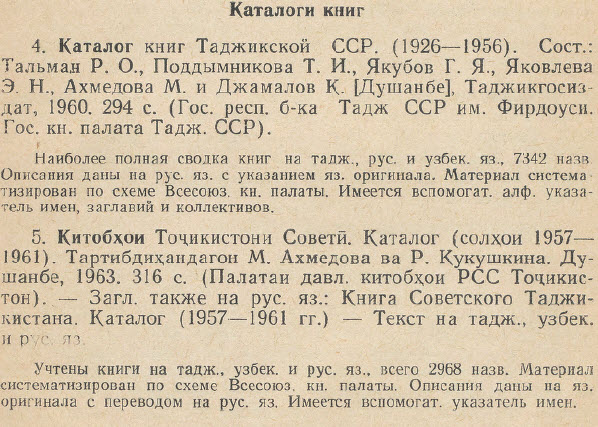
Shevchenko, Z. M., Leĭvi, D. S. Dushanbe: Izdatel’stvo “DONISH,” 1966. U of I Library Call Number: 016.91586 Sh5b International and Area Studies Library, Central Asian Reference. U of I record. OCLC Access Number: 29718128. Bibliografiia bibliografiǐ Tadzhikistana. Section One [Available ONLINE]
Indexes [Available ONLINE]: Author index [immennoǐ ukazatel’: na russkom iazyke, pp.146-153; na tadzhikskom i uzbekskom iazyke, p.154]; Title index[ukazatel’ zaglavii: na russkom iazyke, pp. 155-160; na tadzhikskom i uzbekskom iazykakh, pp. 161]; Geographic index [geograficheskiǐ ukazatel’, pp. 162-164].
Published in 1966, this bibliography of Tojik bibliographies contains approximately 632 entries for general and specialized bibliographies. The considerable amount of publications on Tojikiston published in various scattered items, has not been up to now treated cumulatively in bibliographic literature. The larger bibliographic works existing up to now mostly cover socio-political life of Tojikiston and its natural geography. During the Soviet period a significant number of smaller bibliographic efforts have been published, which now can be listed to give the picture of the existing materials, which have maintained their “practical value.” The areas covered are nature, political system, economics, culture, art, history, language and literature. This bibliography covers the period 1920-1954 and includes works in Russian, Tojikī, and Uzbek languages.
Apart from the bibliographies containing material on local studies (kraevedenie), this work also lists publications that have been published in Tojikiston, as well as those published elsewhere, provided these last ones contain a significant amount of Tojik-related publications. Works on individual scholars have been included if they contained a large number of works on Tojik themes.
The guide does not use publishers’ catalogs (since these were based on projected publishing efforts, and often did not reflect the actual items published). Neither were included the booksellers’ catalogs, since these often contained insignificant and peripheral works. The guide also does not include manuscript catalogs, and the entire guide is devoted strictly to print materials. This bibliography of bibliographies lists all bibliographies published as monographs or brochures, or as separate lists in monographs and journals. Bibliographies that have become duplicated in later works, and which have thus lost their practical value, are mentioned in annotations to the main works. This was done to paint as detailed a picture as possible of the publications on Tojikiston, as well as give the opportunity to librarians (researchers) who may not have access to main works, to see what smaller efforts may address their research topics. Besides separated bibliographies, a number of selected bibliographies accompanying books and articles have been included. These were considered on a case by case basis, depending on their quality and whether they were addressing a topic which is not well covered elsewhere. In cases where there was true dearth of bibliographic coverage, such as in case of certain animals, or art, even very small bibliographic lists were included, sometimes even those found in footnotes. Besides bibliographies devoted to Tojikiston in their entirety, there are also works which encompass all of Soviet Central Asia (Sredniaia Aziia), provided they devoted a significant amount of space to Tojikiston. Similarly, if general bibliographies contain chapters devoted to Tojikiston or Soviet Central Asia, these were also included. This guide is divided into three main parts. The first lists general bibliographies, the second is devoted to bibliographies on the nature of Tojikiston, the third includes bibliographies devoted to the socio-political issues, economics, culture, language, art, and history. If a bibliography covers more than one area, it is listed only in one of the parts, with cross-referencing provided.
Each of the parts begins with a brief introductory essay, which characterize the availability of bibliographic materials on the particular topic, and laying out the principles of dividing the material within the chapter. Usually, general bibliographies open the chapter, followed by bibliographies that shed light on the history of research of a particular issue, with the lists of works of individual researchers closing the chapter. Since this guide is intended to be a practical handbook of sorts, a guidebook to the existing literature, the formal chronological or alphabetical order of arrangement has not been used. Rather, the literature is arranged from the general to the specific. Thus the most complete works on a particular subject are put first, followed by selective (rekomendatel’nye) works. Further we find bibliographies on particular issues, historical periods, or regions of Tojikiston. In the case of the regions the following order is maintained: Northern Tojikiston, Central Tojikiston, Southern Tojikiston, and Pamir. In the case of Pamir, only the most significant works were included. In the final part of the bibliography, in a separate list, the authors show bibliographic works published in Tojikiston, devoted to Tojik issues, but which have lost their practical value. This was done for the purpose of showing the historical development of the bibliographic production in the Tojik Republic. The navigation is aided by a name index, alphabetical list of titles of bibliographies, and a geographical guide. The individual entries contain information on the authors / editors of particular works. In the case of a bibliography being a part of a larger work, the pagination is indicated. Entries devoted to bibliographies found in monographs and journal articles are abbreviated, in comparison to self-contained works. In the case of these bibliographies the number of items devoted to Tojikiston is indicated. If the topic of a bibliography is not clear from its title, it is spelled out in the annotation.
The final materials examined were for January 1965. The compilation of this bibliography was based on the collections of the Central Scientific Library of the Academy of Sciences of Tojikiston(Tsentralnaia Nauchnaia Bibliioteka Akademii Nauk Tadzhikistana) and the Firdousi Republican Library of the Tojik Soviet Socialist Republic (Respublikanskaia biblioteka Tadzhikskoi SSR im. Firdousi). Materials were identified using the annual publication, Bibliografiia sovetskoi bibliografii (for 1939, 1946-1963), as well as numerous secondary bibliographies.
